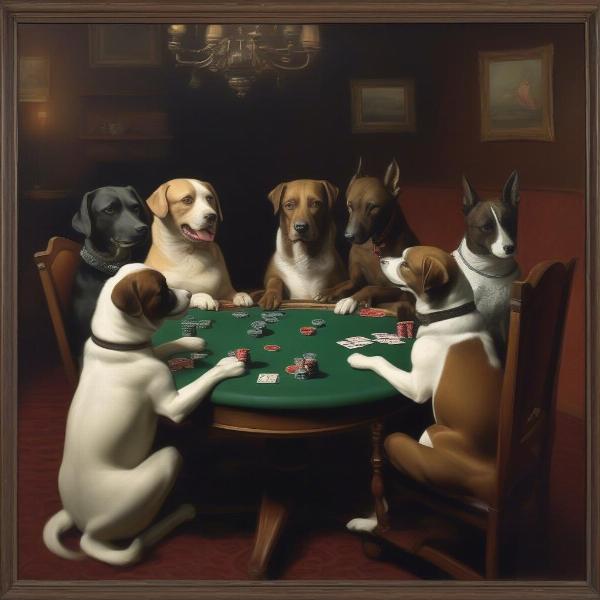Tapestry dogs playing poker is a popular motif, often found adorning walls, throws, and even clothing. But what is the enduring appeal of this image? This article explores the history and cultural significance of the “tapestry dogs playing poker” theme, its connection to canine companionship, and how this iconic imagery reflects our relationship with our furry friends.
The History Behind Dogs Playing Poker
The “dogs playing poker” motif, often seen on tapestries, actually originated as a series of oil paintings commissioned by Brown & Bigelow in the early 1900s to advertise cigars. Artist Cassius Marcellus Coolidge created sixteen paintings in the series, with nine featuring dogs playing poker. While technically not originating on tapestries, the imagery became synonymous with them due to its widespread reproduction on this medium. The original paintings are quite valuable and represent a unique slice of American pop culture.  Original Dogs Playing Poker Paintings
Original Dogs Playing Poker Paintings
The Psychology of Anthropomorphism and Our Canine Companions
The appeal of dogs playing poker lies in the anthropomorphism—the attribution of human characteristics to animals. We see reflections of ourselves in their expressions and imagined actions, finding humor and relatability in the scene. This humanization strengthens our bond with dogs, reminding us of their playful nature and the joy they bring to our lives.
From Canvas to Tapestry: The Evolution of an Icon
The widespread reproduction of the “dogs playing poker” images onto tapestries further cemented its place in popular culture. Tapestries offered a more affordable and accessible way for people to bring this iconic image into their homes. cat and dog jokes The iconic image has transcended its advertising origins, becoming a symbol of lightheartedness, camaraderie, and the special bond between humans and dogs.
Why Dogs Playing Poker Still Resonates Today
The enduring popularity of the dogs playing poker tapestry speaks to our ongoing fascination with our canine companions. We project our own emotions and experiences onto them, creating narratives that resonate with our lives. The humorous juxtaposition of dogs engaged in a human activity like poker highlights the lighthearted and playful aspects of our relationship with these animals. The image offers a nostalgic charm, evoking a sense of comfort and familiarity.
Beyond Poker: Other Canine Art Forms
While poker-playing dogs might be the most recognizable canine motif, it is certainly not the only one. Dogs have been subjects of art for centuries, appearing in paintings, sculptures, and various decorative arts. From dignified portraits of prized hunting dogs to playful depictions of puppies, canine art reflects the diverse roles that dogs play in our lives.
FAQs
- Who painted the original dogs playing poker? Cassius Marcellus Coolidge.
- Were the paintings originally on tapestries? No, they were oil paintings commissioned for cigar advertisements.
- Why are these images so popular? The anthropomorphism and humorous context resonate with dog lovers.
- What other canine art exists? Dogs are featured in various art forms, including paintings, sculptures, and photographs.
- Where can I find dogs playing poker tapestries? They are widely available online and in home decor stores.
- Are the original paintings valuable? Yes, they are considered valuable pieces of American pop culture.
- What is the cultural significance of this imagery? It represents the close bond between humans and dogs and the lighthearted joy they bring to our lives.